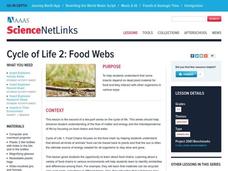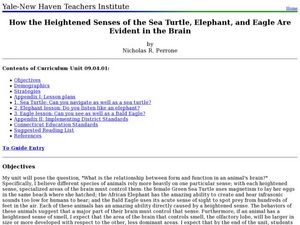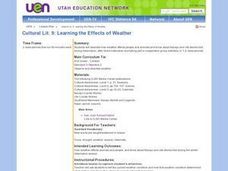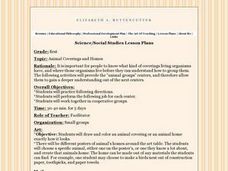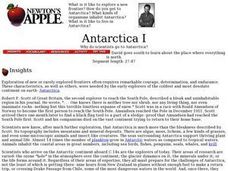Curated OER
Weather and Climate
Pupils identify the words plain and climate and discuss what would happen if it never rained. Students identify and interpret the weather in Poland and create a web illustrating various weather patterns. Pupils write a 4-line poem...
Curated OER
The Peaceable Kingdom
Students examine the life and works of Edward Hicks. Using his "Peaceable Kingdoms, they create what they believe to be their own peaceable kingdom. They compare and contrast the two kingdoms and practice layering colors with colored...
Curated OER
Can you Top That?
Students make connections between their own experiences and the story, "get" the author's message and be able to discuss it with other readers, and apply their reading skills and strategies. They predict what happens in the story,...
Curated OER
Make Your Own Garden
Students explore gardening. In this Quiet in the Garden lesson plan, students read the picture book by Aliki and extend the lesson by taking part in up to 5 hands-on activities.
Curated OER
How Can We Live Here? Life In Extreme Environments
Students explore the limits of life on Earth to extend their beliefs about life to include its possibility on other worlds. They investigate three hypothetical environments and the bacterial life forms that could exist on Earth.
Curated OER
What Do We Know About Africa?
First graders explore Africa, its geography and climate. After completing a KWL chart, 1st graders locate Africa on a globe and discuss how its location on the earth affects its climate. Using the Internet and a given fact sheet,...
Curated OER
Survival in the Land of Batzilla
Young scholars experience a guided inquiry into the workings of an ultrasonic motion detector. They are led to study something they cannot see, hear, feel or taste. Students design strategies to avoid becoming prey of the predatory...
Curated OER
Penguins
Students are immersed in the experience of finding facts and experiences surrounding the concept of penguins. They Go to Banners homepage to read about penguins and then use Kidspiration to conduct a KWL web. Then students complete an...
Curated OER
Science NetLinks: Fossils and Geologic Time
Students investigate the development of the geologic time scale. Also, to introduce them to the major time periods in earth's history, as well as to the role fossils play in helping us understand this history.
Curated OER
Where Are the Dinosaurs?
Students examine the concept of extinction by studying dinosaurs. For this living environment lesson, students view dinosaur video clips and define the word "extinction." Students visit the "Zoom Dinosaur" website to investigate various...
Curated OER
Developing Flags
Students examine why having a symbol such as a flag is important for countries. In this flag lesson, students break into groups and create their own flag to represent their group dynamic.
Curated OER
Desert Animals
Students are asked if they think a roadrunner is a bird that is a fast runner or a slow runner? They are given a copy of Roadrunner Display Sheet. Students are asked how does a roadrunner protect iteself? They are given the following...
Curated OER
Warm up to the Gulf Stream
Students find out the temperature difference between the Gulf Stream and the surrounding water. They locate the Gulf Stream on the infrared image of the eastern seaboard of the US.
Curated OER
Forest Habitats
In this identification lesson, 3rd graders view photographs of different kinds of forests, learn where forests are located, and discuss seasonal changes in forests. Students read Look What I Did With a Leaf, collect leaves, identify what...
Curated OER
Different Environments
Pupils read literature selection, discuss habitat, divide habitats into different categories such as water, soil, and land, list animals that live in each habitat, and describe habitats using descriptive words in vocabulary list.
Curated OER
How the Heightened Senses of the Sea Turtle, Elephant, and Eagle Are Evident in the Brain
Students explore the senses of different animals. For this biology lesson plan students will study the animals selected for their grades. The students will learn about the brain and how the senses of that animal have developed.
Curated OER
Learning the Effects of Weather
Second graders examine how weather affects animals and people. They discuss Navajo and Ute stories told during different seasons of the year, and create a drawing of people or animal behavior and the connection to the weather.
Curated OER
Animal Coverings and Homes
First graders research what kind of coverings living organisms have, and where those organisms live before they can understand how to group them. The following activities will precede the "animal groups" centers, and therefore allow them...
Curated OER
Explore the Arctic: A Scavenger Hunt
Learners explore the Arctic region using the internet. They identify characteristics of animals that live in the Arctic and locate the Arctic region using a map of the United States.
Curated OER
Water Pollution, Stream Ecosystems
Students participate in a series of simulated activities designed to demonstrate the interconnectedness between the environment and the organisms that live there. They explore how polluting one element of an environment affects the...
Curated OER
Verterbrate Classification
Students are introduced to the broad categories of vertebrates including fish, amphibians, reptiles, birds and mammals. They identify the characteristics of each group and then view slideshows and video of example species.
Curated OER
Antarctica I
Students explore exploring and expiditions then simlate their own on campus. They divide into small "expedition groups." Have each team report back to the class about their expeditions, using written, oral, or videotaped presentations.
Curated OER
Classification 2: A Touch of Class
Young scholars examine how many kinds of living things (e.g. plants and animals) can be sorted into groups in many ways using various features to decide which things belong to which group and that classification schemes vary with purpose.
Curated OER
The Edge of Home
Students explain why some species of plants and animals occur in more than one area. They watch as the teacher puts an overlapping circles on the chalkboard, students are asked to predict what kinds of things they would expect to find in...











